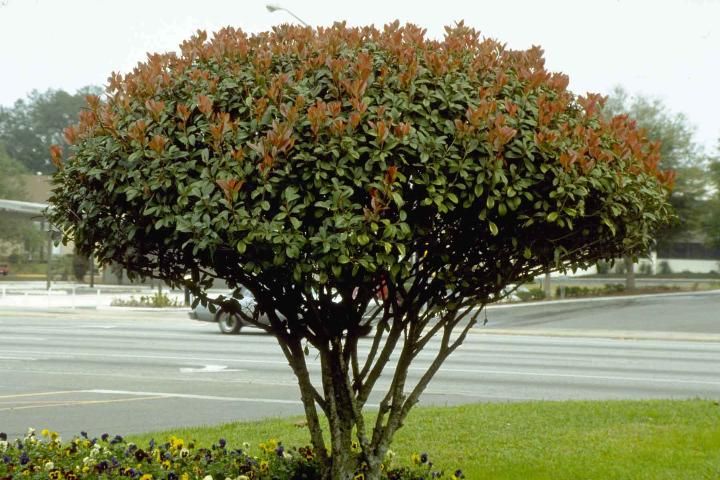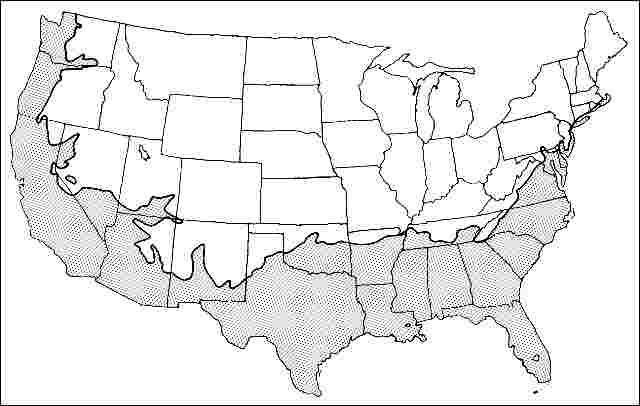Introduction
Widely planted for its attractive, bright-red, new leaf growth, Japanese photinia is a densely-foliated, broadleaf evergreen which grows 15 to 20 feet in height. Bright red leaves among the dark green ones afford a bit of foliage interest throughout the fall and winter in southern climates (USDA hardiness zones 8 and 9). The fragrant, four-inch-wide flower clusters appear in early spring and are followed by somewhat showy, red berries which ripen to black.

Credit: Ed Gilman, UF/IFAS
General Information
Scientific name: Photinia glabra
Pronunciation: foe-TIN-nee-uh GLAY-bruh
Common name(s): Red-leaf photinia, red-top
Family: Rosaceae
USDA hardiness zones: 7A through 11 (Fig. 2)
Origin: not native to North America
Invasive potential:has been evaluated using the IFAS Assessment of the Status of Non-Native Plants in Florida's Natural Areas (UF/IFAS 2018). This species is not documented in any undisturbed natural areas in Florida. Thus, it is not considered a problem species and may be used in Florida.
Uses: deck or patio; screen; hedge; trained as a standard; container or planter; street without sidewalk; parking lot island < 100 sq ft; parking lot island 100-200 sq ft; parking lot island > 200 sq ft; sidewalk cutout (tree pit); tree lawn 3-4 feet wide; tree lawn 4-6 feet wide; tree lawn > 6 ft wide; urban tolerant; highway median
Availability: somewhat available, may have to go out of the region to find the tree

Description
Height: 15 to 20 feet
Spread: 10 to 15 feet
Crown uniformity: symmetrical
Crown shape: oval, vase, round
Crown density: dense
Growth rate: fast
Texture: medium
Foliage
Leaf arrangement: alternate (Fig. 3)
Leaf type: simple
Leaf margin: serrate
Leaf shape: obovate, elliptic (oval)
Leaf venation: pinnate, reticulate
Leaf type and persistence: evergreen, broadleaf evergreen
Leaf blade length: 2 to 4 inches
Leaf color: green, purple/red
Fall color: no color change
Fall characteristic: not showy

Flower
Flower color: white/cream/gray
Flower characteristics: showy
Fruit
Fruit shape: round
Fruit length: less than .5 inch
Fruit covering: fleshy
Fruit color: red, black
Fruit characteristics: does not attract wildlife; showy; fruit/leaves not a litter problem
Trunk and Branches
Trunk/bark/branches: branches don't droop; not showy; typically multi-trunked; thorns
Pruning requirement: little required
Breakage: resistant
Current year twig color: reddish, brown
Current year twig thickness: medium
Wood specific gravity: unknown
Culture
Light requirement: full sun
Soil tolerances: clay; sand; loam; slightly alkaline; acidic; well-drained
Drought tolerance: high
Aerosol salt tolerance: high
Other
Roots: not a problem
Winter interest: no
Outstanding tree: no
Ozone sensitivity: unknown
Verticillium wilt susceptibility: susceptible
Pest resistance: sensitive to pests/diseases
Use and Management
Often used as a hedge or dense screen, Japanese photinia can easily be trained into a multi-trunked small tree for patio or specimen use. It is occasionally sold as a standard, with all the branches originating from the top of a four- to five-foot-tall straight trunk. Photinia does not make a good clipped hedge because it will not keep foliage on the lower branches, grows too rapidly and does not branch enough. But it will form a nice tall screen. It can be used to frame a residential street by planting properly trained specimens on 10 to 15 foot centers. Although the red foliage color contrasts well in most applications, landscape designers avoid planting it against a red brick wall because it clashes with brick.
Growing best in full sun on moist, organic soils, photinia grows rapidly and is very tolerant of hard pruning.
The cultivar 'Rubens' has bright, bronze-red young leaves.
Propagation is by cuttings.
Pests
Mites, scales, aphids, and caterpillars are occasional pests but do no major damage.
Diseases
It is susceptible to fire blight and leaf spot which can cause serious defoliation. Be sure to locate plants in full day sun to help prevent these devastating diseases.
Literature Cited
University of Florida, Institute of Food and Agricultural Sciences. 2018. "Assessment of Non-native Plants in Florida's Natural Areas" (https://assessment.ifas.ufl.edu, 4/29/2019) Gainesville, FL, 32611-4000, USA.